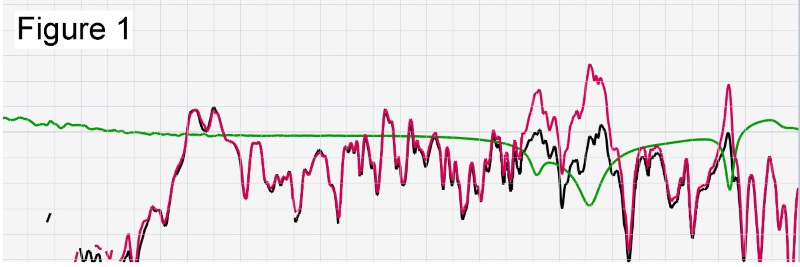Dear Jonah:
My audio analyzer software has an option to invert the frequency response. Why would I want to do this? – John B.
An important distinction here – the “Inverted Trace” function doesn’t alter the measurement data at all, it just displays it differently. Specifically, it vertically mirrors the trace, flipping it upside down.
To illustrate why that’s useful, Figure 1 shows the frequency response of a horrendously bad monitor wedge (in red), and a few filters’ worth of applied EQ (green) to deal with the worst of the response peaks, with the result shown in black.

Hopefully you don’t have to work with anything quite this terrible, but it illustrates the point: You can see how the EQ cuts directly counteract the response peaks.
Figure 2 shows the same exact measurements, only with the EQ trace inverted, which allows us to easily verify that the EQ parameters are a good fit for the peaks we’re attempting to equalize. This makes the data a bit easier to visually parse and helps streamline the optimization process.

Dear Jonah:
I mix in a very reverberant concert hall, and when we have presenters wearing lavalier microphones, it’s really hard to control feedback. Any tips? – Steve
There’s no “magic bullet” but there are some things you can do to win back a few precious dB of gain before feedback.
First, remember the basic options for increasing potential gain: get the mics closer to the sources, and keep the sources and the mics away from the loudspeakers. We can’t usually tell presenters where they can or cannot stand, and you might not be able to move the loudspeakers around, but you can make sure of good placement with the lav mics.
Most lavs are omnidirectional, which is not a great choice when feedback rejection is an issue. Suggest cardioid handheld mics if the client/presenters are open to it.
Either way, get ahead of the game with a couple of tricks. Start by turning up the gain of each mic until they’re just on the verge of feedback, then try flipping the channel’s polarity.
The feedback with either get worse or better. Stick with the beneficial polarity setting for each mic. Then bring the gain up again until the mic starts to ring and use a narrow EQ filter to cut that frequency. Wash, rinse, and repeat.
Here’s one more trick (but don’t tell anyone I told you): For presenters located at center stage, low-frequency feedback is common because they’re standing in the power alley created by the LF summation of both sides of the system. Inverting the polarity on one side of the mains turns this summation into a cancellation. If you’re also using the system for things other than speech, this isn’t a great solution and can still result in a funky-sounding vocal out front in the middle of the house, so test it ahead of time. Sometimes the results are surprisingly effective.
Dear Jonah:
I’m considering using egg crates as acoustic treatment in my control room. Is this a good idea or a bad one? – Anonymous
The problem with egg crates is that they’re actually a decent absorber of high frequencies but are too thin to do anything useful in the lower-frequency region, which is where small rooms have the most trouble. So in a way, egg crates can actually make things worse by absorbing only the highs and tilting the room’s response toward the low end, which can sound “muddy” and unpleasant.
Particularly if you’re on a budget, you can’t go wrong with Owens Corning 703 rigid fiberglass, the go-to material for do-it-yourself acoustic treatment. It’s inexpensive to buy in bulk, and there are a lot of great resources out there to help you understand placement and measurement. I’d start with Ethan Winer’s “Audio Expert” forums.















